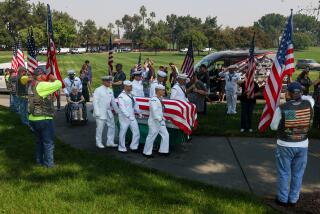Military Messengers of Death Ready for Duty : Armed forces: A Long Beach Navy team, like others around the country, will notify relatives when loved ones have died in action.
In the upstairs closet of Navy Lt. Cmdr. Mary Jo Sweeney’s Huntington Beach home, a midnight-blue uniform hangs in a plastic dry-cleaning bag, creased and ready. She leaves it there, blue service ribbons taut and gold officer’s buttons shined, in case she is called to duty by Operation Desert Storm.
Sweeney is death’s messenger, responsible for notifying relatives of Long Beach-based Navy personnel that their loved ones have died in action. Every night for the last two weeks, Sweeney, administrator of a detail of death-notification officers at the base, has been startled awake, as if by a nightmare, around 4 a.m.
“Will I get a call saying one of our ships is hit?” she wondered, lying there. “And if I do, will I have enough officers to make notifications to their families?”
That was before the war. Now, with the outbreak of hostilities, Sweeney and counterparts in military bases around the country have begun thumbing through thick, leather-bound notebooks that govern the politesse of military death.
Behind the Navy base’s front gates, where military police confronted visitors Thursday morning with cold scrutiny, officers and enlisted crews mulled reports that Long Beach’s own battleships and destroyers in the Persian Gulf were pitching Tomahawk missiles into Iraq. Sailors’ lives potentially were on the line. A well-aimed Iraqi missile, a suicide bomber, even a shipside accident, Mary Jo Sweeney realized, could kill.
She has made four death calls in her 12-year Navy career and hopes not to make another. Yet, despite reports of only one American fatality after the first day of fighting, Sweeney has reluctantly begun bracing herself and her “casualty-assistance call officers” to do it again.
“I watched television last night with an awareness we might have to go to work,” said Sweeney, who in normal times is a base administrator. “It’s the most emotionally taxing assignment there is. It brings you very close to the reality of death.”
Sweeney, 31, is tall, blunt-spoken and career Navy. She clutches her wrists when she talks of death. She has memorized the formal, antiseptic lines that the Navy requires its death-notification officers to recite, mastering their delivery in flat tones that betray nothing.
The message is as brief as a funeral notice, delivered in less than a minute. The words vary only by the name of the dead, the manner of death and a few official details.
It begins: “The secretary of the Navy has asked that I inform you. . . .”
It ends: “I extend to you and your family my deepest sympathy for your great loss.”
Until the death message is spoken, nothing else must be said. Relatives’ startled questions go unanswered. Not until the official notification is given can a casualty-assistance call officer relax the mask imposed by duty.
It is done that way in the Navy, as it is in all the armed services, Sweeney said, so that relatives understand that the officer at the door is a messenger, not a counselor or a culprit.
“We’re not trying to be callous,” Sweeney said. “You don’t knock on a door and say, ‘Johnny’s dead.’ Some people just can’t handle it. They order you out of the house. They say, ‘The Navy killed my son.’ That’s what the procedures try to minimize.”
Afterward, death-notification officers can relax, talk to the families, give limited details about the deaths, even offer limited sympathy. They are told, though, to always use the word dead .
“Relatives need to start assimilating the news immediately,” Sweeney said. “We don’t use phrases like passed away .”
The messengers always return to the home a day later. There are details to work out with survivors--funeral arrangements, death benefits, wills, legal affairs.
Because Sweeney now heads the Navy base’s death-notification detail--a team that changes each night--she is less likely to make calls herself. But the chance of fatalities among senior officers in the gulf or a rash of shipside deaths could easily overwhelm her staff, forcing her back into action.
“You have to expect anything,” she said.
Sweeney was not quite as steeled to the task when she answered her first death call, in San Diego five years ago.
A young Navy flier had been killed in a flight accident. Sweeney went home and took out her full dress uniform--a dark-blue skirt and jacket with gold stripes on the sleeves. She adjusted her service ribbons and donned a dark cap that Navy women call a “bucket.”
She was scared, her mouth dry. As she drove with a Navy chaplain to the home of the dead boy’s mother, Sweeney rehearsed her lines. Outside the house, her line of vision seemed to cave in.
“It was like being in a tunnel as I walked to the door,” she recalled.
A middle-aged woman, dressed in what Sweeney recalled as “California casual clothes,” answered. The woman’s eyes grew wide. A disjointed question about her son tumbled out. Sweeney stuck to her script, listening to the drone of her own voice. She sounded “very serious.”
When the brunt of the message sunk in, the woman sagged. Then, the Navy chaplain took over, comforting the woman, allowing Sweeney to find a seat inside on a couch. She gathered her notes, and when it was done, she drove home, emotionally drained.
More to Read
Sign up for Essential California
The most important California stories and recommendations in your inbox every morning.
You may occasionally receive promotional content from the Los Angeles Times.










